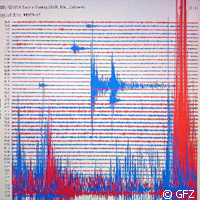German researchers map out Japanese earthquake sequence
The international community has been shocked and horrified by the images of devastation and tragedy in the wake of the horrific events triggered by the 11 March earthquake which rocked the Sendai region of Japan. As a result of the earthquake and the tsunami, the death toll currently stands at over 6,000, and extremely cold conditions as well as the threat of radiation from the Fukushima nuclear power plant continue to overwhelm communities on the island. With a magnitude of 8.9 on the Richter scale, the earthquake was one of the strongest ever recorded worldwide, but scientists in Germany have uncovered evidence that a series of almost equally as strong foreshocks also took place. Researchers at the German Research Centre for Geosciences (GFZ) have put together an animation which shows the whole sequence of quakes starting from 8 March, two days before the quake which triggered the tragic events causing huge loss of life and displacement of communities. Their findings uncover the following sequence of events. After a quiet 8 March, on 9 March a foreshock with a Richter magnitude of 7.2 took place at almost exactly the same point where the tsunami and earthquake on 11 March hit. Although activity slowly subsided, since then earthquakes reaching a magnitude of 6 have been registered on a daily basis. In total, 428 aftershocks have been recorded in the region of Honshu since 9 March. GFZ scientists Rongjiang Wang and Thomas Walter also found that due to horizontal displacements, the island of Honshu has shifted up to five metres in an eastwards direction. The source of the earthquake, where displacement occurred between the continental shelves during the quake, was reconstructed using global positioning stations (GPS) measurements. The scientists then used this data to calculate the vertical displacement of the seabed, which in this case occurred over an area about 500 km long and 100 km wide. Computer simulations put together by the researchers show that where the contact interface of the Pacific plate - a long oceanic tectonic plate that lies beneath the Pacific Ocean - meets Japan, an offset of up to 25 metres occurred during the earthquake. Some of the data even shows a displacement of up to 27 metres in places and a vertical movement of 7 metres. The catastrophic tsunami that followed was caused by the abrupt elevation of the deep sea, which rose by up to seven metres. This elevation at the heart of the earthquake of the coast of Japan was also mapped out by the scientists. GFZ scientists Andrey Babeyko and Stephan Sobolev modelled the propagation and wave heights of the tsunami in the Pacific over the first 16 hours. Relatively large wave heights of over one meter were calculated in the open Pacific, which highlights the sheer force of the earthquake. The force of a Tsunami multiplies as it travels towards the shoreline and gains in power. The speed with which tsunamis spread also depends on water depth. In shallow water they can reach speeds of around 30 km/h to 50 km/h and in deep oceans this rises to over 800 km/h. In deep, open sea, the wave crests are harmless and low, mostly between 30 cm and 80 cm. As they approach the coast, especially in shallow bays, they can reach heights of over 10 metres, and in extreme cases they can be more than 30 metres to 50 metres high, causing flooding up to several kilometres inland. As events unfold in Japan, understanding the causes and patterns of the Earth's movements has never been more pressing.For more information, please visit: German Research Centre for Geosciences (GFZ):http://www.gfz-potsdam.de
Countries
Germany, Japan



